© Kate Garnham
Conservation grazing
What is conservation grazing?
Using livestock for conservation grazing purposes has increased in popularity in recent years with many land managers mimicking traditional farming methods using livestock to restore and maintain habitats.
By using traditional, or rare breeds, we can select livestock that are best suited to the habitats and those species that rely on them. For example, Exmoor ponies have evolved over many thousands of years to thrive on rough forage and low-nutrient grazing. This makes them invaluable for browsing invasive species such as hawthorn and thistles that are unpalatable to more modern breeds. Through our grazing, we carefully balance the wildlife aims of each site with the welfare needs of the livestock.
How conservation grazing helps nature?
When livestock are allowed to graze freely they select different plants, and even different parts of the plant, to nibble or browse. Over time, this selective eating by the animals creates a varied structure within the plants and the habitat. It is this that helps create the right conditions for a wide range of insects, birds, reptiles, mammals, and plants to exist.
What are the alternatives?
Without being able to graze, the only options would be mowing or burning. Both of these techniques cause rapid and dramatic habitat change and leave behind a uniform structure. Mechanical methods cannot replicate the unique conditions that grazing animals create because they pick and choose what they eat throughout the year.
Meet the team!
Our grazing team comprises of native breeds of cattle, sheep and ponies. We have a herd of nearly 240 cows, a flock of 275 sheep and 3 native ponies. These animals are at the heart of our work – helping us to maintain our nature reserves for the benefit of local, vulnerable wildlife.
We choose to use native and traditional based breeds because we believe they are best suited to thrive in our local landscapes, where their diet will be very varied, sometimes rough and low in nutrients. These types of breeds are also docile so well suited to be grazing reserves with visitors.
Shetland Cattle
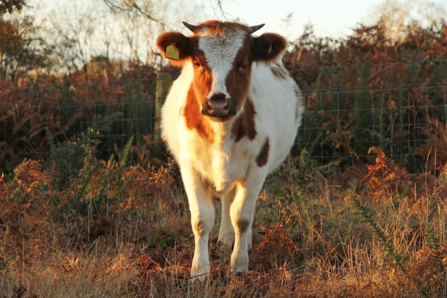
With their lightweight physique and large hooves, shetland cattle prevent ground damage and soil compaction in soft grazing areas. Their hardiness and adaptability suit various habitats in nature reserves. Shetlands have a versatile diet, consuming grasses like rushes, coarse herbs, and thistle tops. They also browse a wide selection of shrubs, including young heather, contributing to habitat maintenance and balance.
British White Cattle
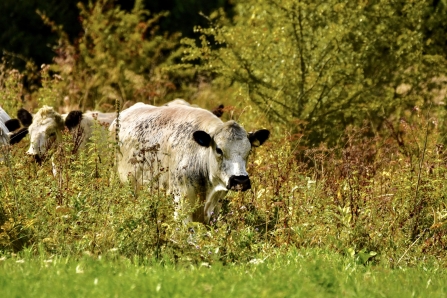
Renowned for their exceptional conservation grazing abilities, British white cows play a vital role in preserving natural landscapes. They effectively manage habitats, maintain biodiversity by consuming coarse grasses and invasives, and their gentle nature minimizes disruption to fragile ecosystems, promoting vegetation regeneration.
Hereford Cattle
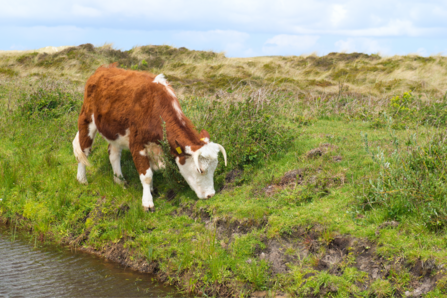
An old breed indigenous to the region, Hereford cattle exhibit a remarkable resilience that allows them to thrive outdoors throughout the year. They possess a preference for grazing on coarse vegetation, shrubs, and trees, enabling them to thrive even in areas with low-quality pasture. Their hardiness and adaptability make them well-suited for various environmental conditions, making the Hereford breed a reliable choice for sustainable grazing practices.
Shetland Sheep
© Sarah Weston
These sheep are ideal for conservation grazing in woodlands. They selectively browse on invasive species, promoting native grasses and wildflowers. Their light-footed grazing minimizes soil erosion and damage to sensitive areas, preserving the ecological balance.
White-faced Woodland Sheep
© HIWWT Kate Garnham
These sheep are ideal for conservation grazing in woodlands. They selectively browse on invasive species, promoting native grasses and wildflowers. Their light-footed grazing minimizes soil erosion and damage to sensitive areas, preserving the ecological balance.
Hebridean Sheep
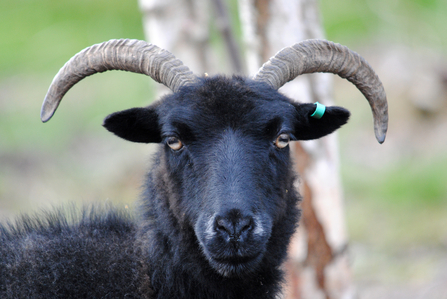
© Amy Lewis
We have a small flock of Hebridean sheep on the Isle of Wight. This small but tough breed are a favourite for conservation grazing. They have a more browsing method of feeding than other sheep breeds and are able to thrive on plants of low nutritional value. Their black fleece is thick and water repellent, so they are suited for all weathers.
Exmoor Ponies
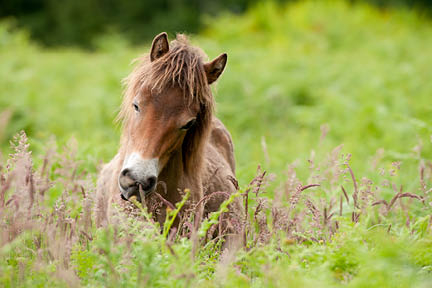
© Ross Hoddinott/2020VISION
Exmoor ponies excel in grazing and play a vital role in maintaining diverse habitats. These sturdy and hardy ponies have evolved to thrive in challenging environments, including upland areas. With their efficient grazing habits, Exmoor ponies consume a wide range of grasses, herbs, and shrubs, preventing the dominance of certain plant species. They have a selective grazing behaviour, often targeting coarse and fibrous vegetation, which promotes biodiversity by allowing more delicate plant species to flourish. The ponies' grazing also helps maintain open landscapes and prevents the encroachment of scrub vegetation. Their small size and nimbleness allow them to access areas inaccessible to larger livestock, making them ideal for managing and preserving various habitats.
New Forest Ponies
© Sarah Weston
New Forest ponies possess exceptional grazing abilities and are crucial for the conservation and management of the New Forest area in southern England. These ponies are highly skilled at consuming a diverse range of vegetation, including grasses, heather, gorse, and shrubs. They have evolved to thrive on a diet that includes grazing, browsing, and selective feeding. Unlike cows and sheep that typically graze closer to the ground, New Forest ponies are adept at reaching higher foliage and using their nimble mouths to strip leaves from trees and shrubs. Their browsing behaviour contributes to the maintenance of woodland edges and the prevention of excessive vegetation growth. With their natural grazing and browsing instincts, New Forest ponies play a vital role in shaping the landscape and maintaining the unique ecology of the New Forest.
